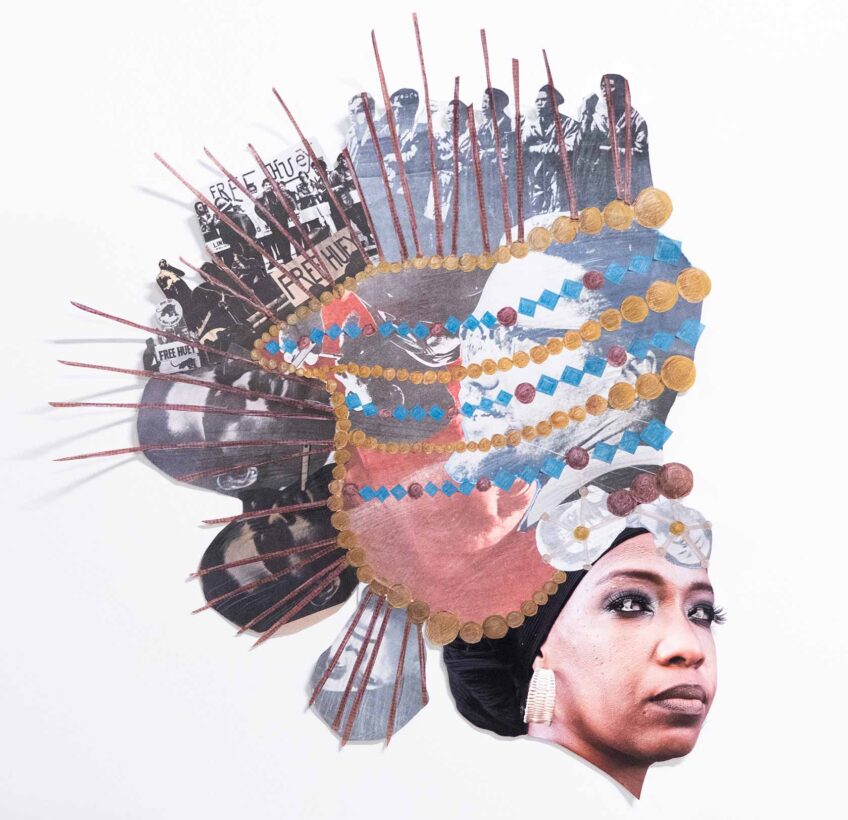

Joan Jonas and Jason Moran at the Boston premier of “Reanimation” at the Museum of Fine Arts, Boston.
Reanimation, the title of a performance and film by renowned conceptual artist Joan Jonas, suggests a sci-fi tale. But the hour-long work of music, movement and video conjures an actual phenomenon: an endangered Arctic, where loss of snow and ice from global warming threatens ancient habitats.
Thursday night, Jonas and jazz pianist Jason Moran performed the Boston premiere of Reanimation at the Museum of Fine Arts Boston.
Both beguiling and urgent in its rendering of an eroding wilderness, the work was inspired by the novel Under the Glacier, by Nobel Prize-winning Icelandic author Halldór Laxness. In the book, a theology student is sent to investigate a volcanic crater in which prehistoric life still stirs, defying the toll of time.
As Jonas and Moran performed, a film by Jonas played on a large screen that took center stage, like a painting. Around it were various props — bells, horns, and rattles suggestive of ancient cultures — and a drafting table fitted with a microphone and live video feed. An easel displayed a small watercolor of a tree.
A revered pioneer of performance art who in the ’60s became one of the first visual artists to bring video and movement into her works, Jonas is an alumna of the School of the Museum of Fine Arts and Professor Emerita at the Massachusetts Institute of Technology. She will represent the U.S. at the 2015 Venice Biennale, the oldest and largest exhibition of contemporary art.
Moran, 39, collaborated with Jonas on the score, a mix of live and prerecorded music. He accompanied Jonas on the piano and also wove in passages of rock-tinged electronica.
A New England Conservatory faculty member and artistic director of jazz at the Kennedy Center in Washington, D.C., Moran has an appetite for adventurous partnerships, including ventures connecting the past and present of African-American music and projects with conceptual artists Lorna Simpson and Glenn Ligon that explore race and identity.
A striking and slender woman with white hair, Jonas, 78, clad herself in an array of white costumes. With a dancer’s nimbleness and a strong and melodic voice, she had a riveting stage presence.
Chameleon-like, Jonas wielded her arsenal of props and costumes to evoke figures from folk tales — priestly shamans and shape-shifting tricksters with the power to heal and protect nature from harm.
She picked up a branch with chalk at its tip, and, brandishing it like a magic wand, began drawing angular shapes resembling snowflakes. At the drafting table, Jonas rippled sheets of plastic, creating a clatter like that of water rushing over stone.
Moving in the spare, ritualistic style of actors in a traditional Japanese Noh theater performance, Jonas made each gesture deliberate, even the rough way she tossed the sheets to the floor when she was done with them.
In one segment, Jonas donned a mask and drew the shape of a polar bear on her white tunic, as if to speak for this endangered inhabitant of a diminishing Arctic. At another point, she stood directly in front of the video screen, shielding herself with a white shade. Slowly moving up and down, she seemed to melt into the film and float above the landscape.
As transfixing scenes of treeless landscapes unfolded on the screen, the pace of the movement and music varied from slow, contemplative passages to torrents of sound evoking surging cascades of snowmelt.
Moran began with lyrical, wandering accompaniment that turned the film into a dreamscape. Later, his improvisations took a staccato, percussive turn, as the film showed scenes of Arctic lands crossed with power lines.
Pulling on a blue knit cap, Jonas took up her bells and horn and joined Moran for a passage of high-energy music, as if sounding an alarm.
As the performance came to a close, the movement, music and video imagery rose to a wild, chaotic peak, as if long submerged forces were bursting into life.

![Banner [Virtual] Art Gallery](https://baystatebanner.com/wp-content/uploads/2024/05/Breathe-Life-4-ToGetHe_WM-150x150.jpg)


![Banner [Virtual] Art Gallery](https://baystatebanner.com/wp-content/uploads/2024/05/Breathe-Life-4-ToGetHe_WM-848x751.jpg)

